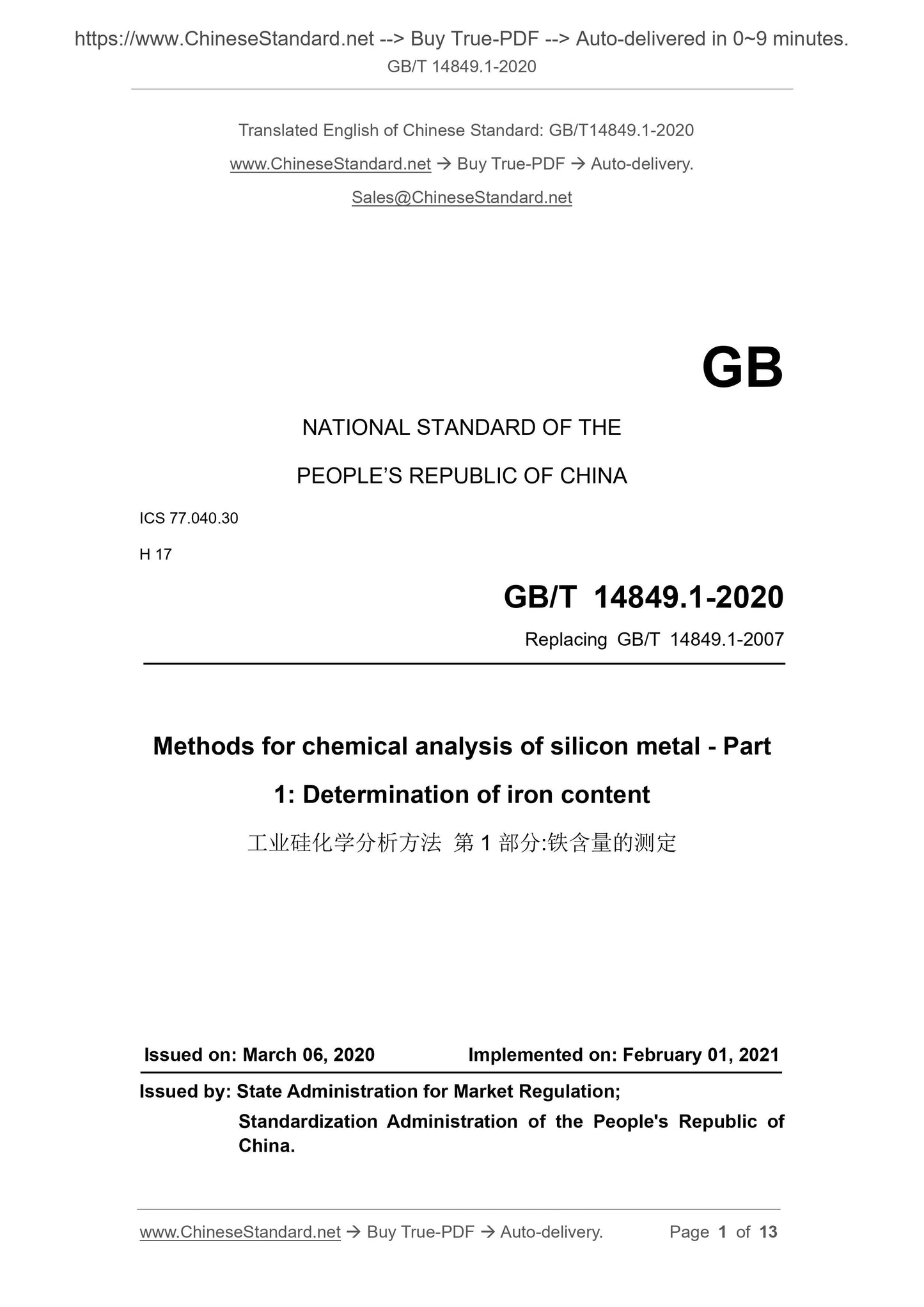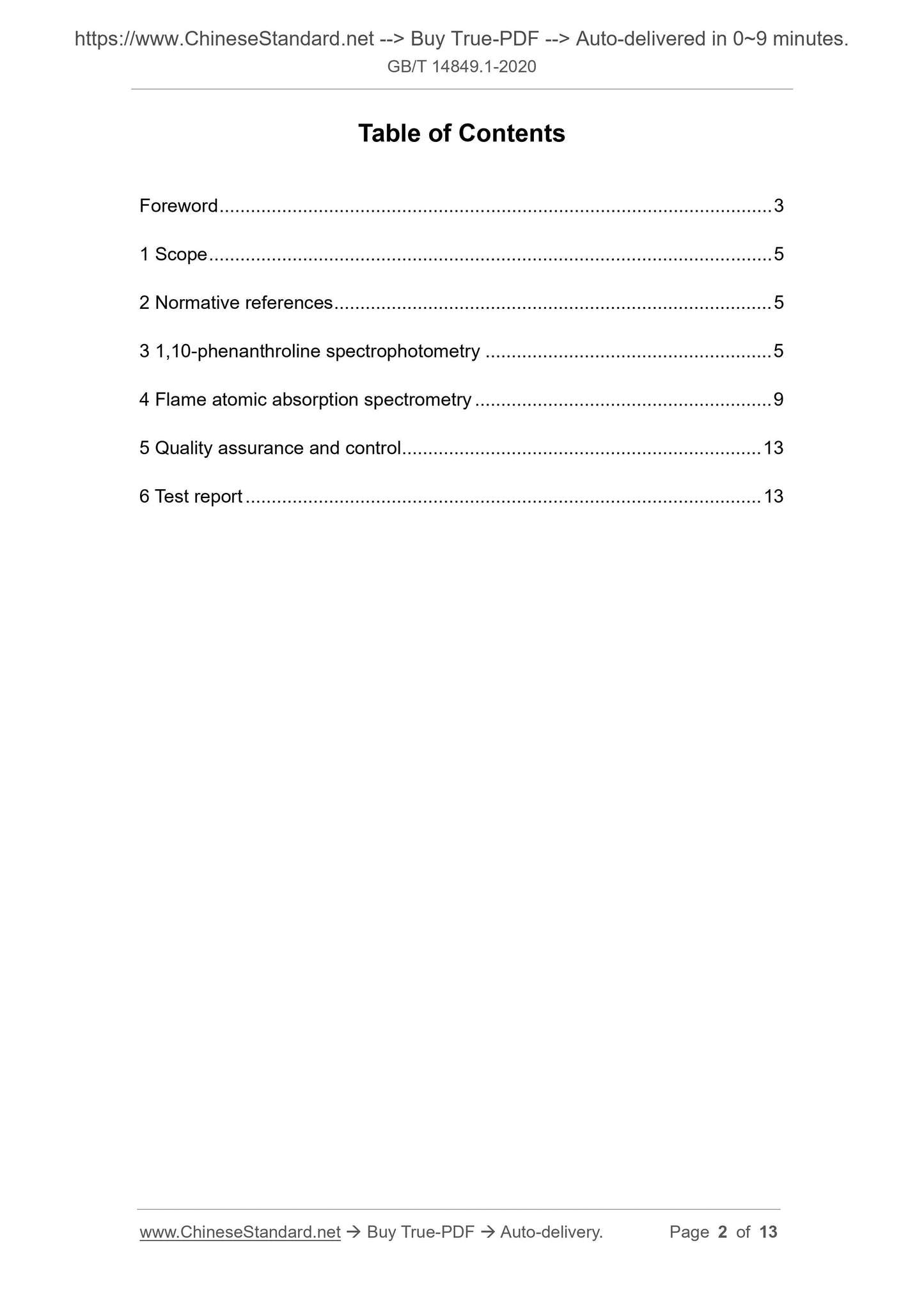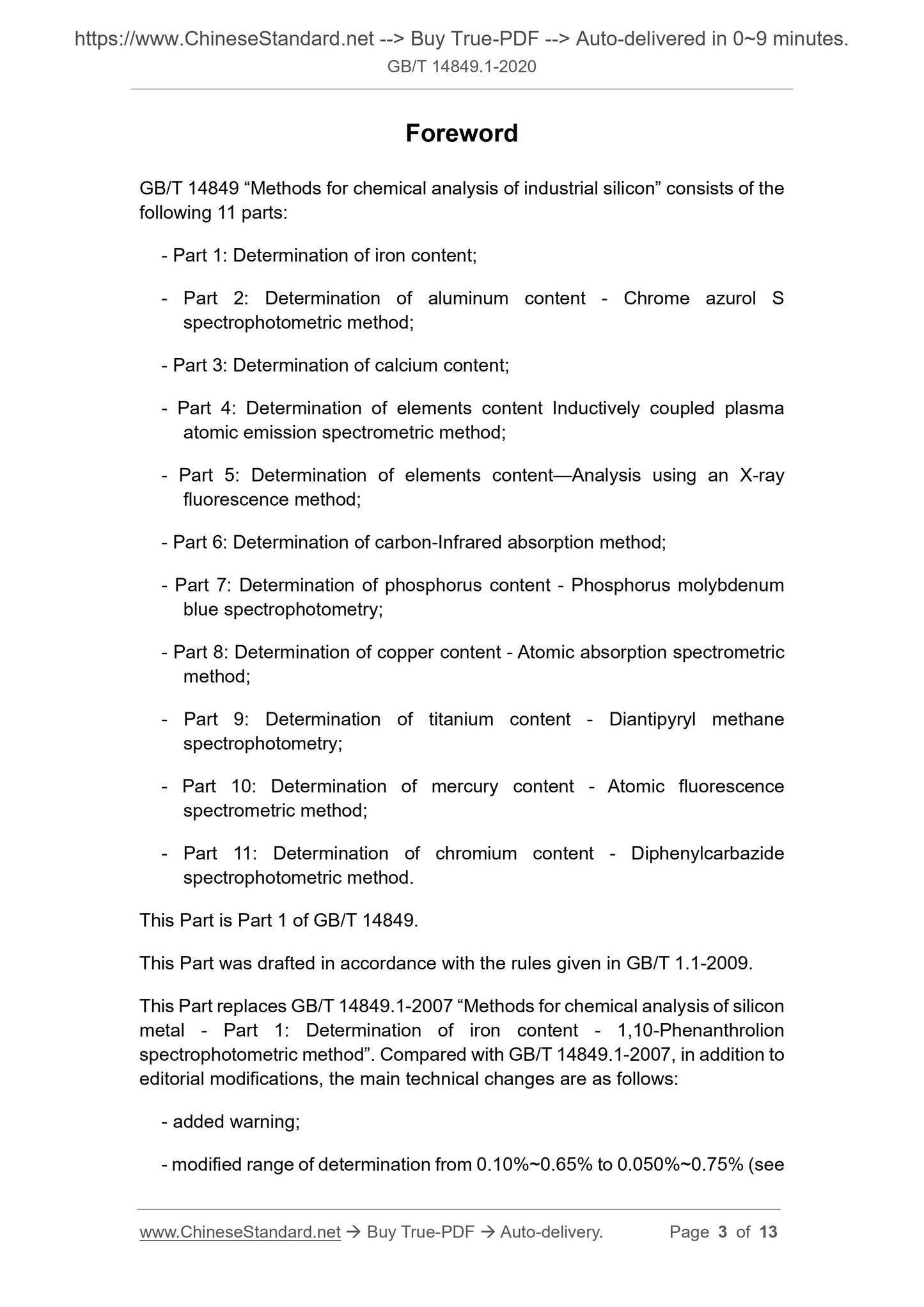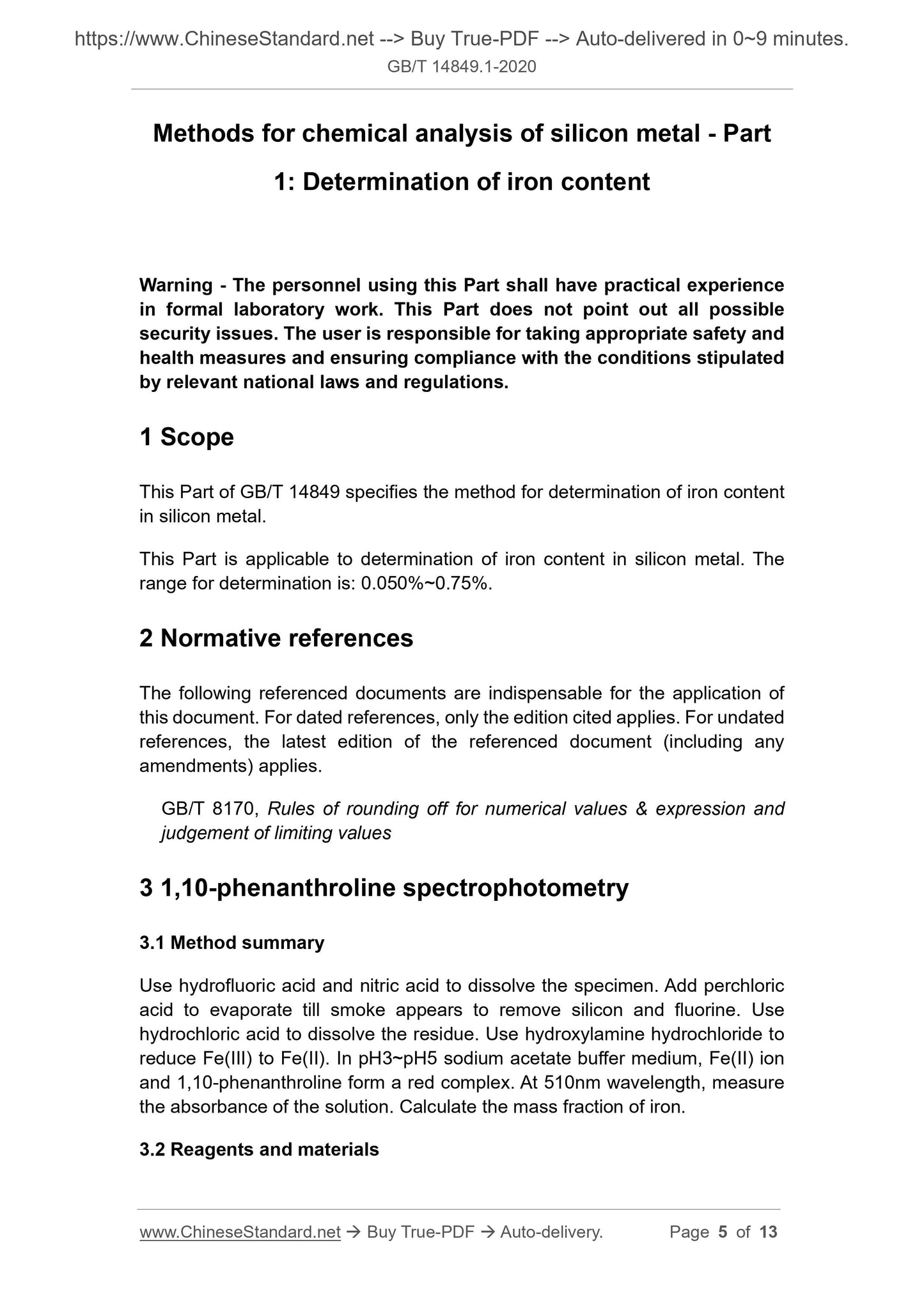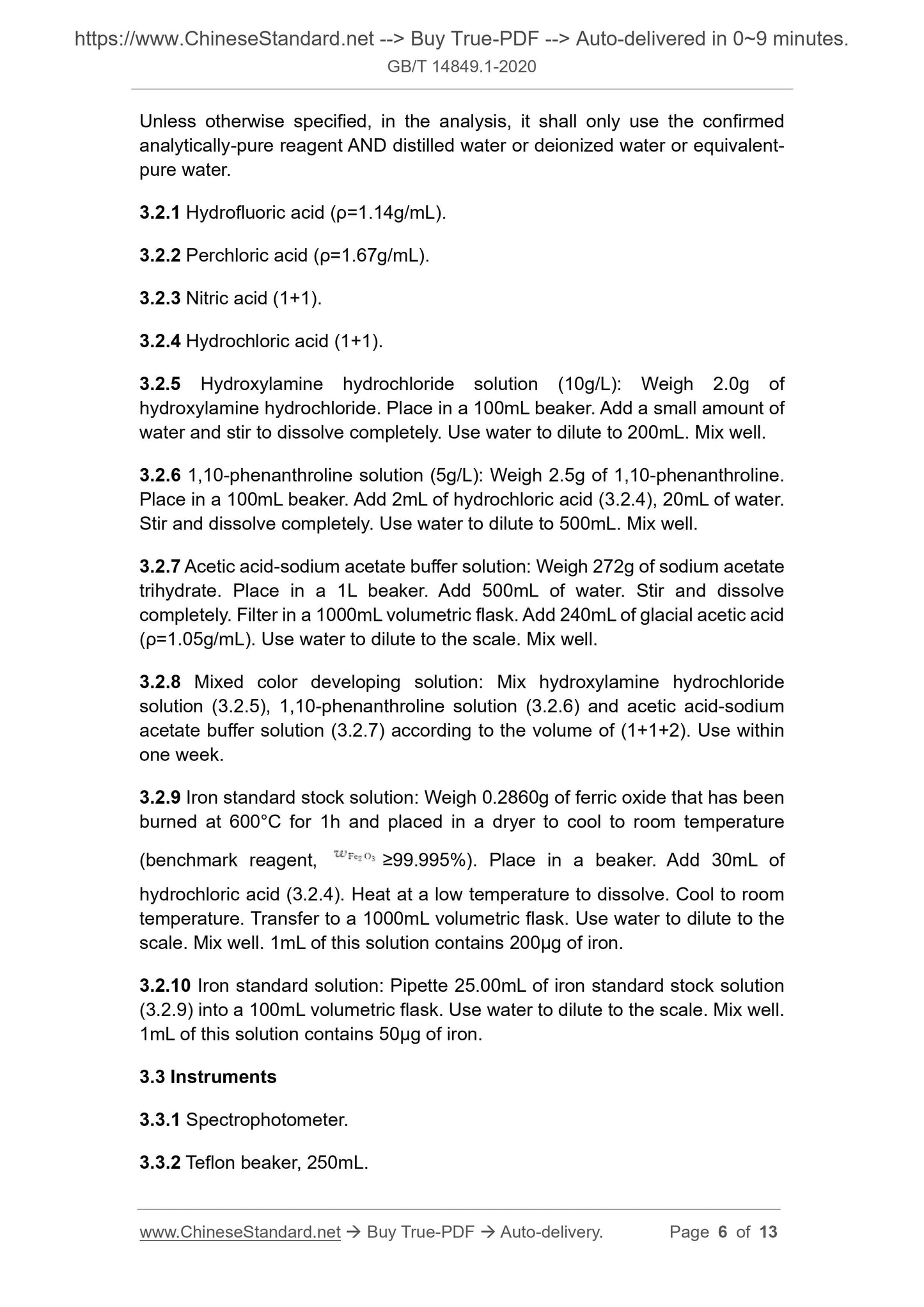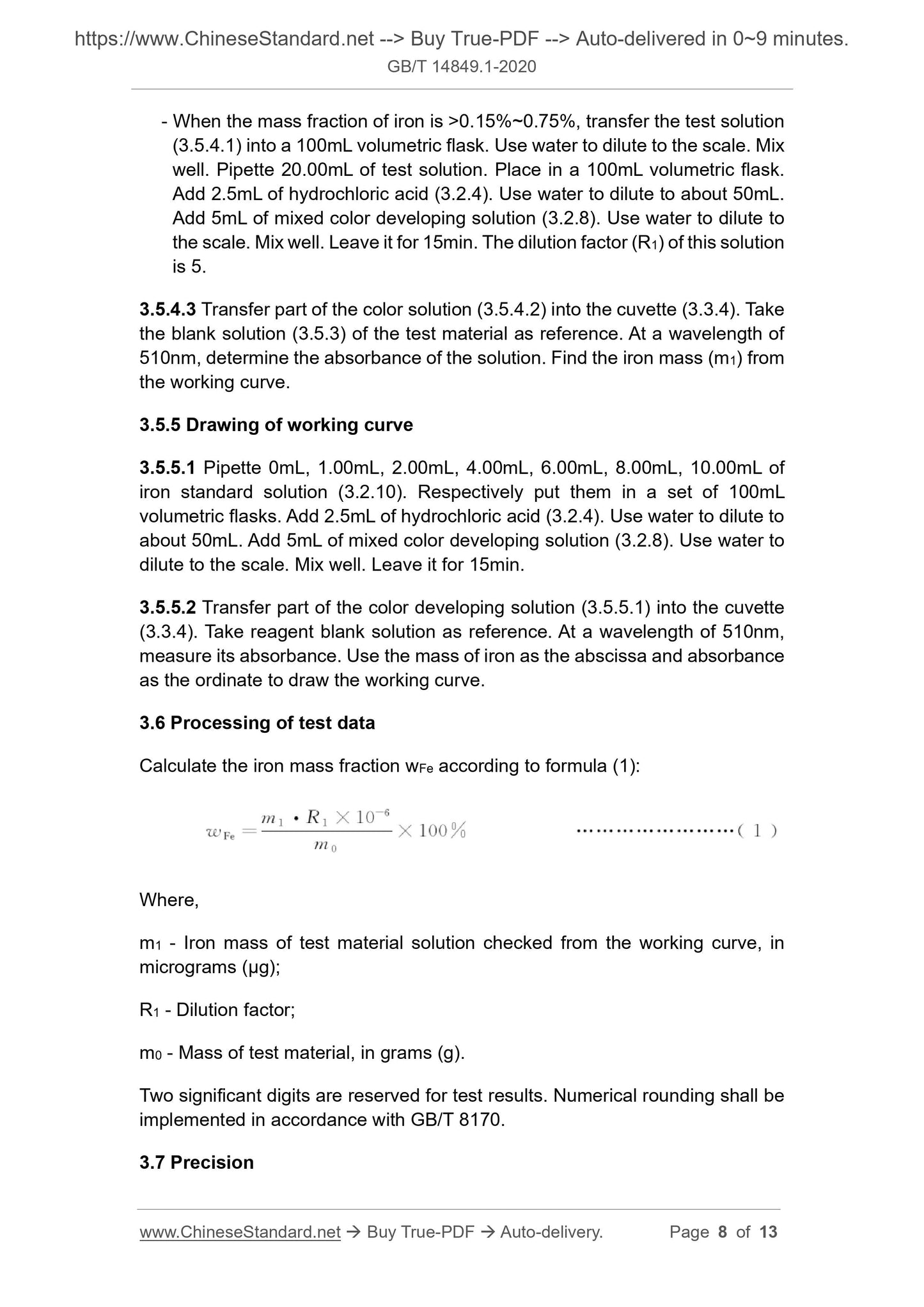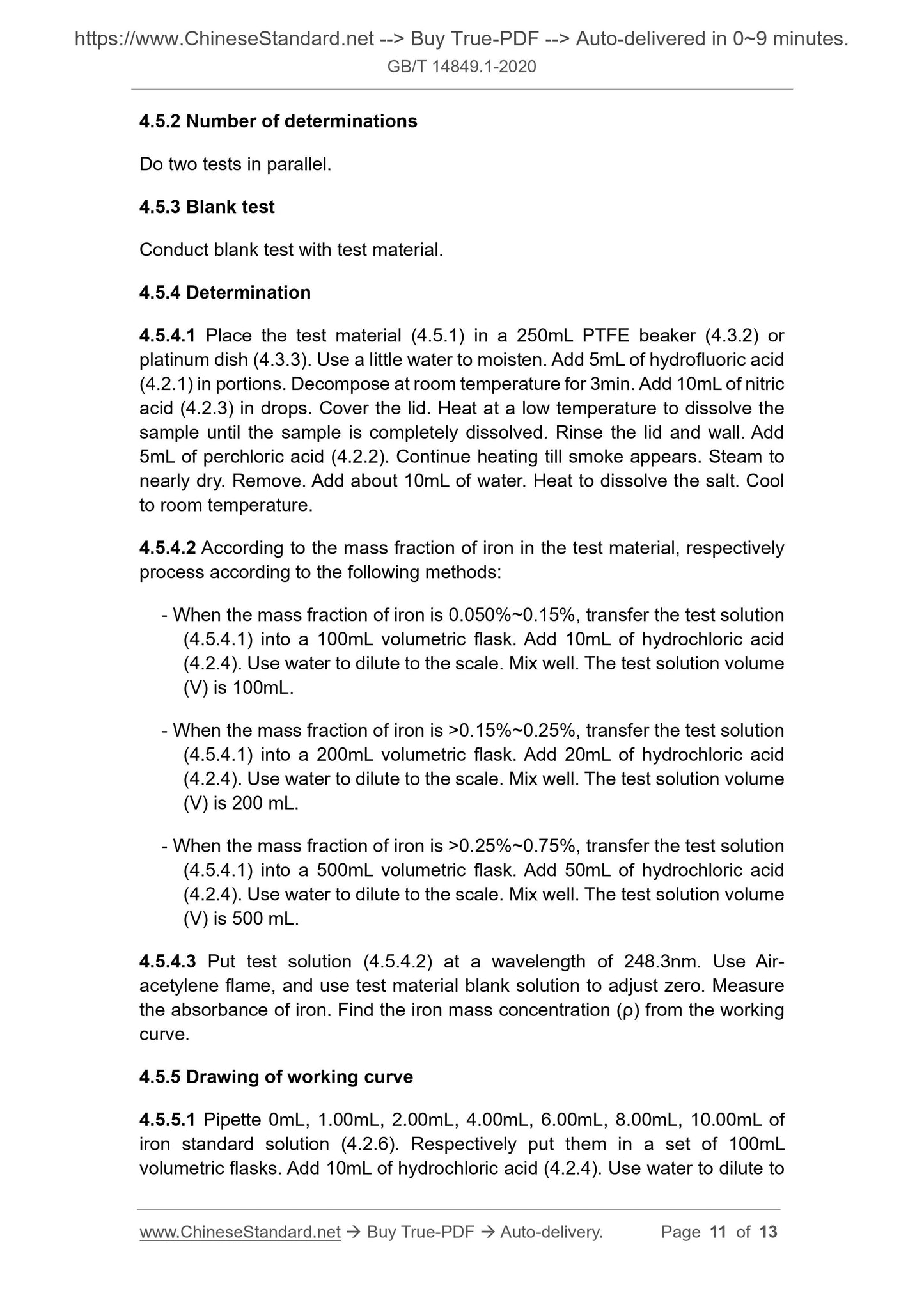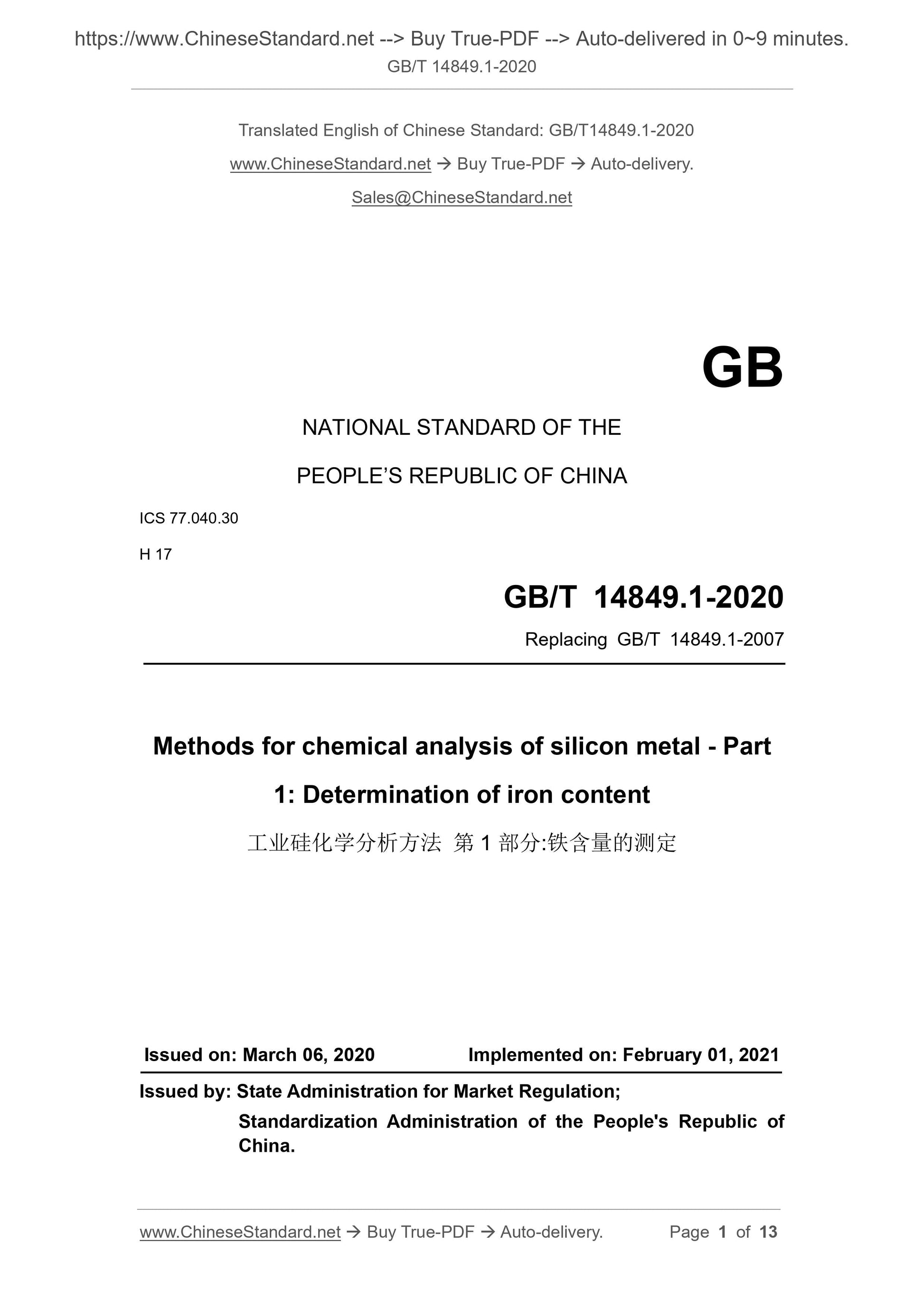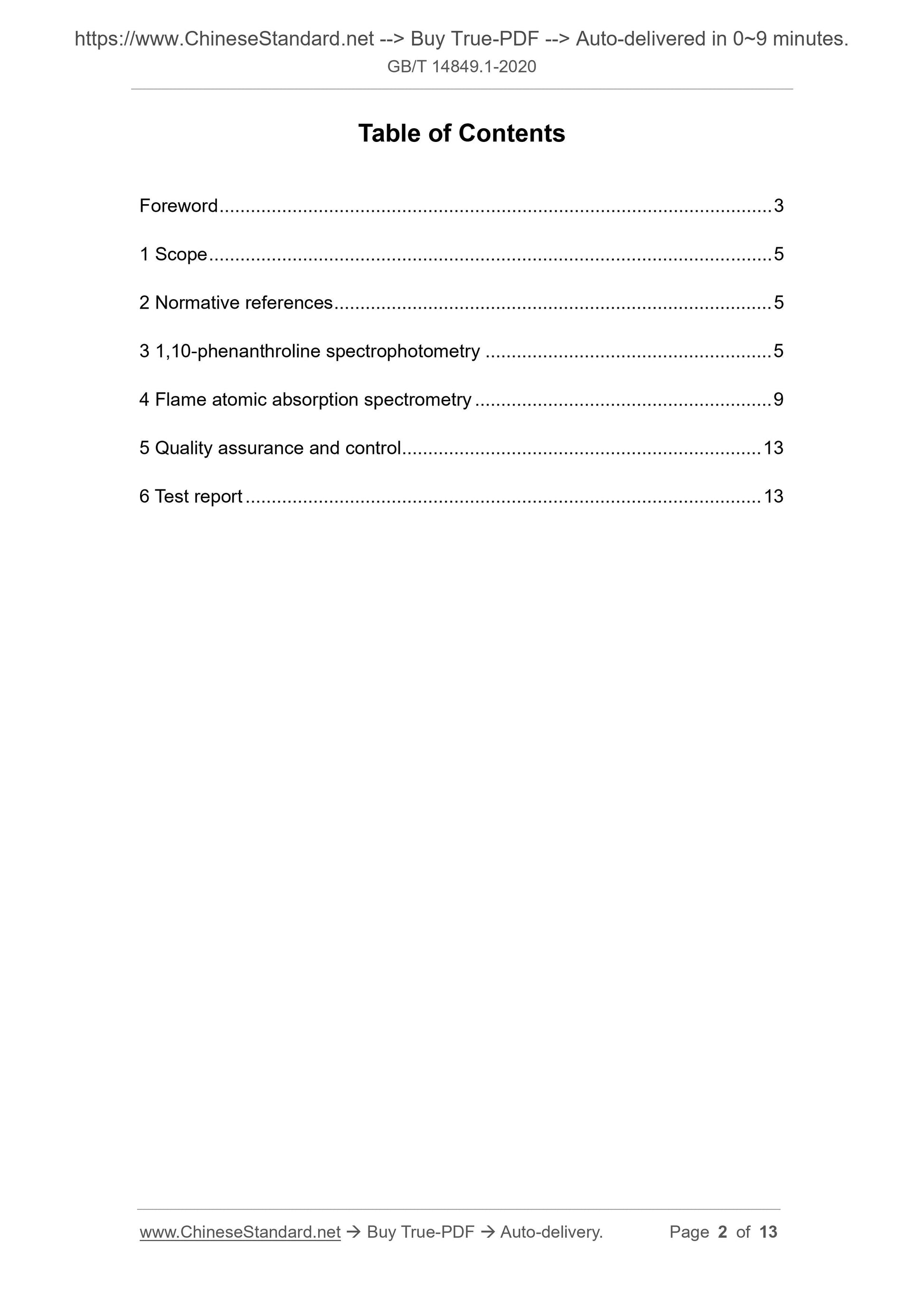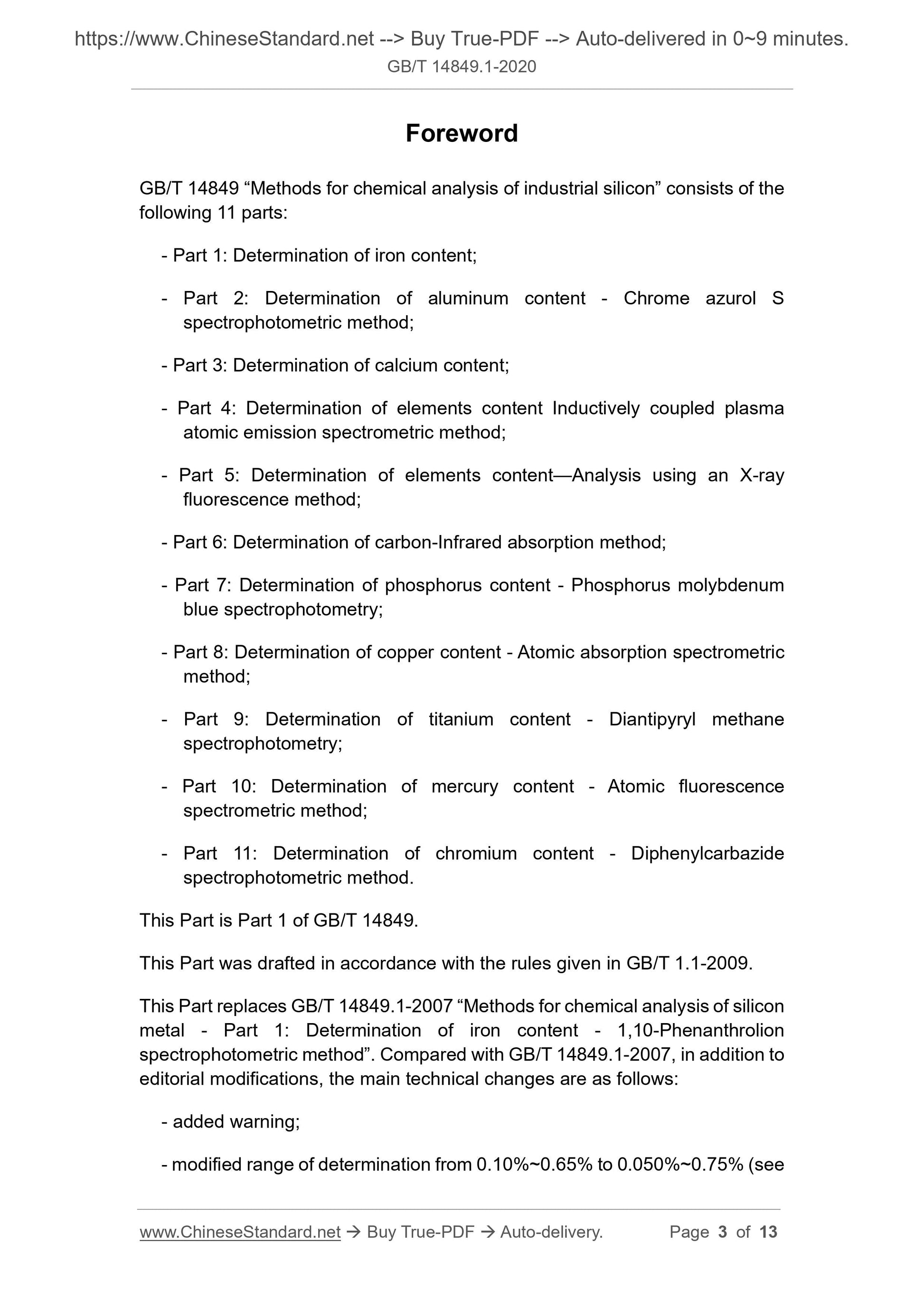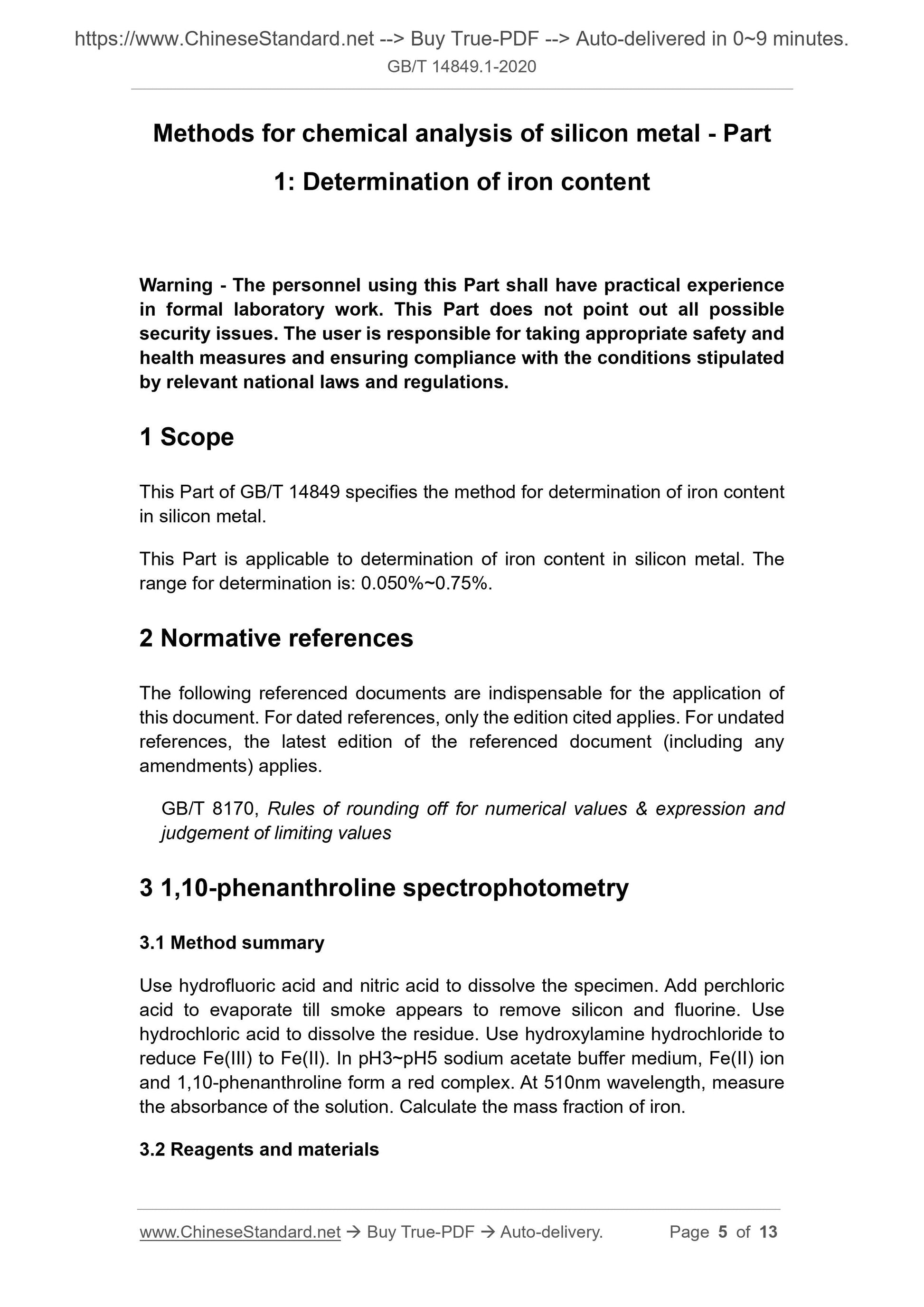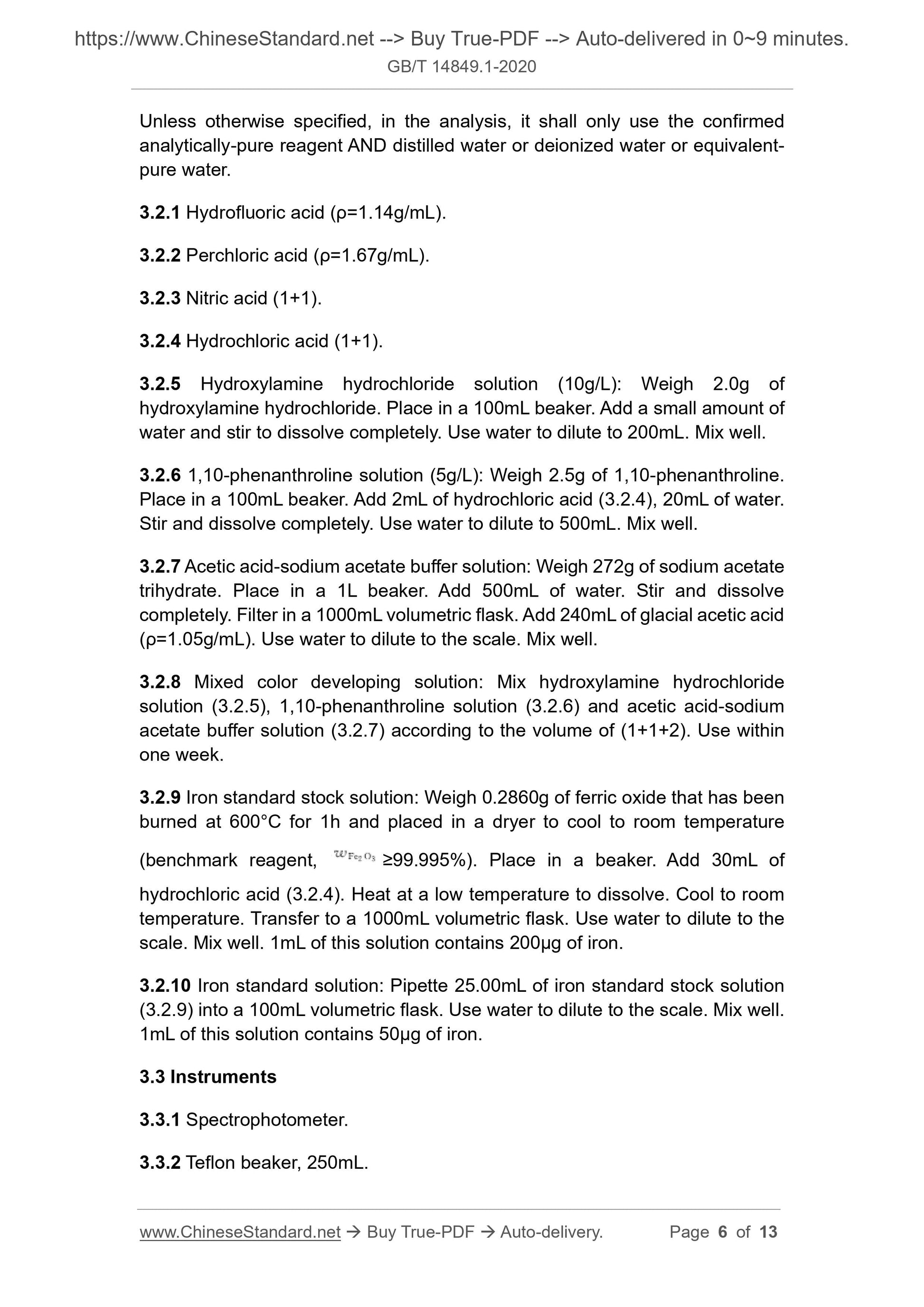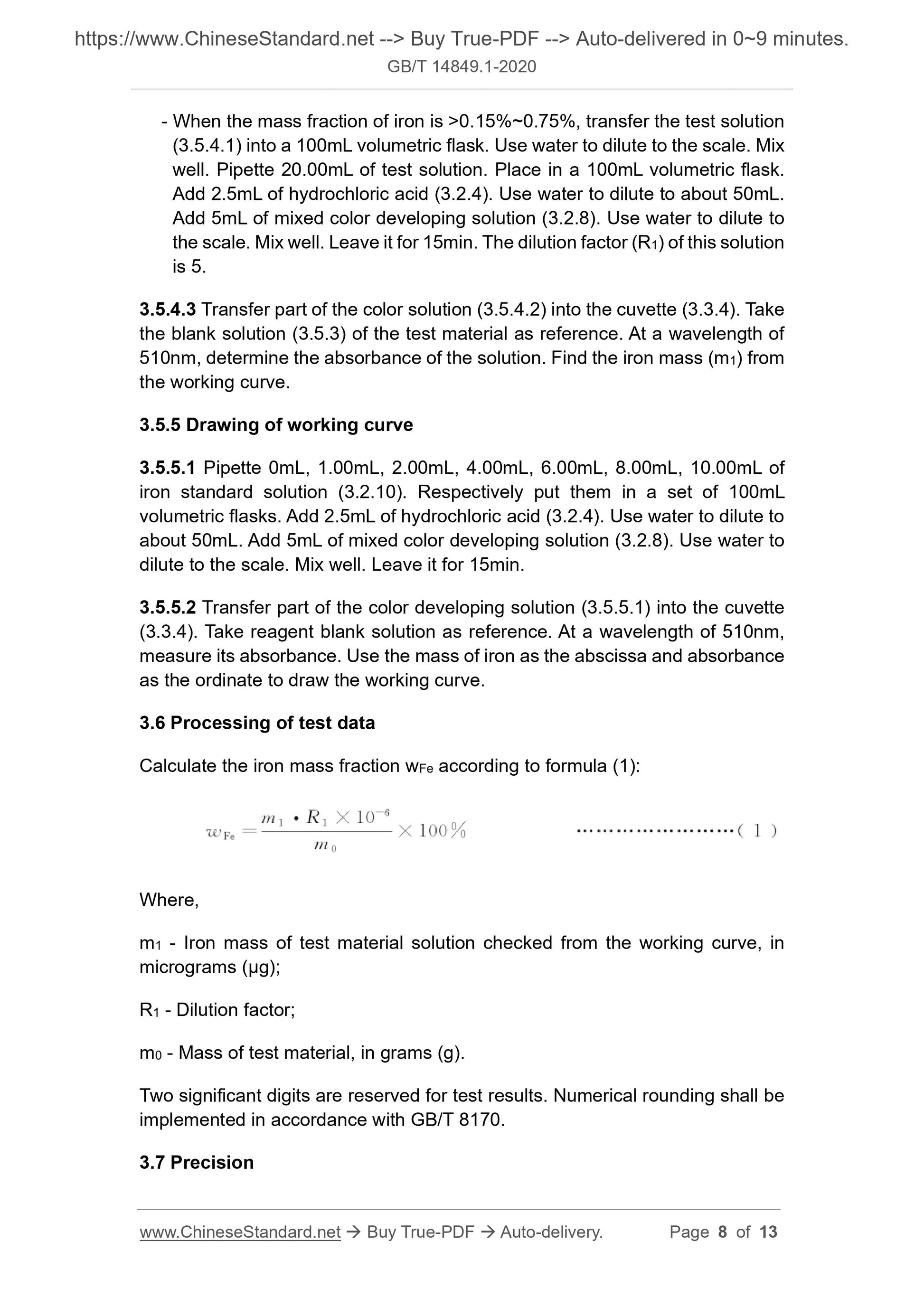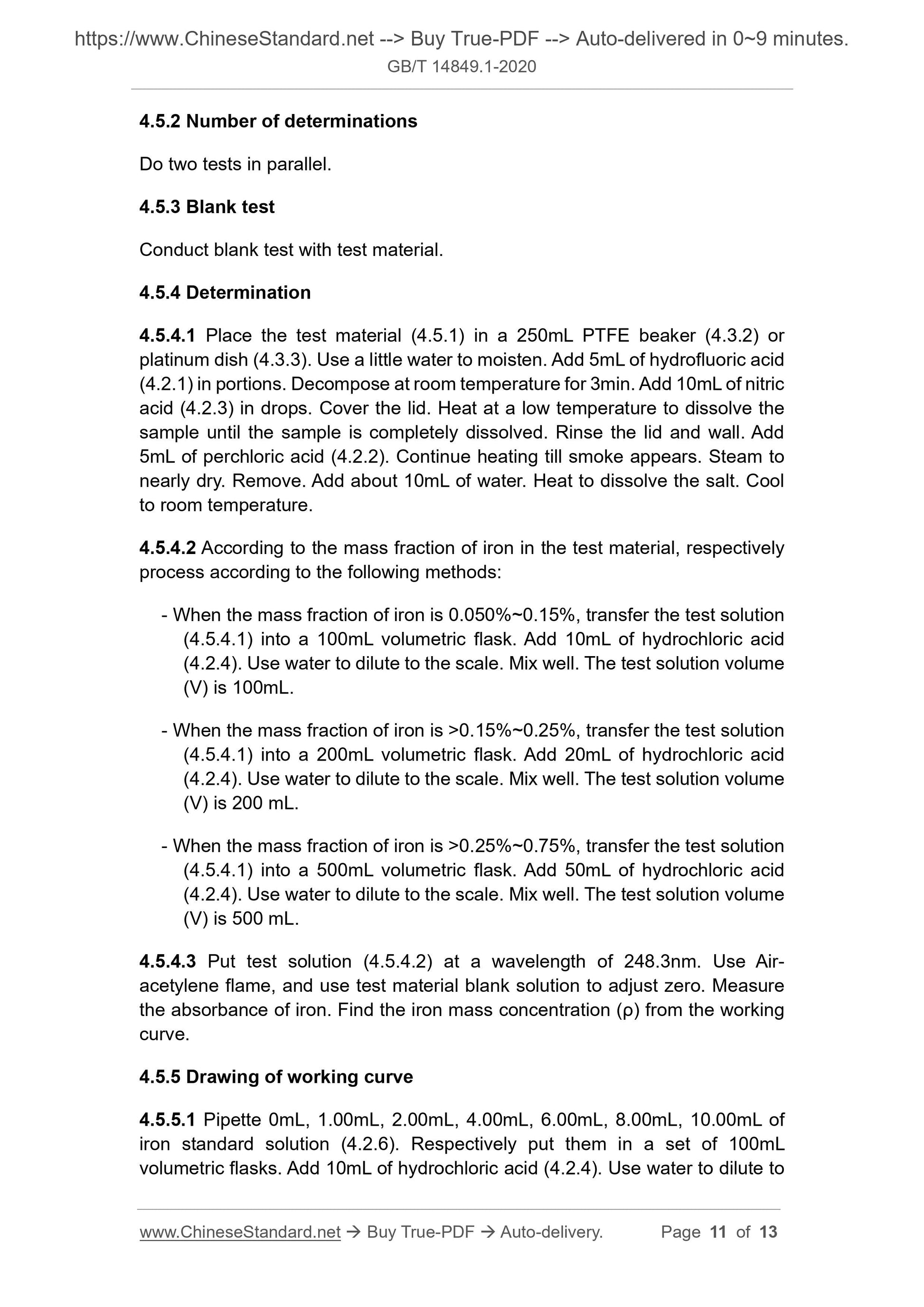1
/
of
7
www.ChineseStandard.us -- Field Test Asia Pte. Ltd.
GB/T 14849.1-2020 English PDF (GB/T14849.1-2020)
GB/T 14849.1-2020 English PDF (GB/T14849.1-2020)
Regular price
$155.00
Regular price
Sale price
$155.00
Unit price
/
per
Shipping calculated at checkout.
Couldn't load pickup availability
GB/T 14849.1-2020: Methods for chemical analysis of silicon metal - Part 1: Determination of iron content
Delivery: 9 seconds. Download (& Email) true-PDF + Invoice.
Get Quotation: Click GB/T 14849.1-2020 (Self-service in 1-minute)
Historical versions (Master-website): GB/T 14849.1-2020
Preview True-PDF (Reload/Scroll-down if blank)
GB/T 14849.1-2020
GB
NATIONAL STANDARD OF THE
PEOPLE’S REPUBLIC OF CHINA
ICS 77.040.30
H 17
Replacing GB/T 14849.1-2007
Methods for chemical analysis of silicon metal - Part
1: Determination of iron content
ISSUED ON: MARCH 06, 2020
IMPLEMENTED ON: FEBRUARY 01, 2021
Issued by: State Administration for Market Regulation;
Standardization Administration of the People's Republic of
China.
Table of Contents
Foreword ... 3
1 Scope ... 5
2 Normative references ... 5
3 1,10-phenanthroline spectrophotometry ... 5
4 Flame atomic absorption spectrometry ... 9
5 Quality assurance and control ... 13
6 Test report ... 13
Foreword
GB/T 14849 “Methods for chemical analysis of industrial silicon” consists of the
following 11 parts:
- Part 1: Determination of iron content;
- Part 2: Determination of aluminum content - Chrome azurol S
spectrophotometric method;
- Part 3: Determination of calcium content;
- Part 4: Determination of elements content Inductively coupled plasma
atomic emission spectrometric method;
- Part 5: Determination of elements content—Analysis using an X-ray
fluorescence method;
- Part 6: Determination of carbon-Infrared absorption method;
- Part 7: Determination of phosphorus content - Phosphorus molybdenum
blue spectrophotometry;
- Part 8: Determination of copper content - Atomic absorption spectrometric
method;
- Part 9: Determination of titanium content - Diantipyryl methane
spectrophotometry;
- Part 10: Determination of mercury content - Atomic fluorescence
spectrometric method;
- Part 11: Determination of chromium content - Diphenylcarbazide
spectrophotometric method.
This Part is Part 1 of GB/T 14849.
This Part was drafted in accordance with the rules given in GB/T 1.1-2009.
This Part replaces GB/T 14849.1-2007 “Methods for chemical analysis of silicon
metal - Part 1: Determination of iron content - 1,10-Phenanthrolion
spectrophotometric method”. Compared with GB/T 14849.1-2007, in addition to
editorial modifications, the main technical changes are as follows:
- added warning;
- modified range of determination from 0.10%~0.65% to 0.050%~0.75% (see
Methods for chemical analysis of silicon metal - Part
1: Determination of iron content
Warning - The personnel using this Part shall have practical experience
in formal laboratory work. This Part does not point out all possible
security issues. The user is responsible for taking appropriate safety and
health measures and ensuring compliance with the conditions stipulated
by relevant national laws and regulations.
1 Scope
This Part of GB/T 14849 specifies the method for determination of iron content
in silicon metal.
This Part is applicable to determination of iron content in silicon metal. The
range for determination is: 0.050%~0.75%.
2 Normative references
The following referenced documents are indispensable for the application of
this document. For dated references, only the edition cited applies. For undated
references, the latest edition of the referenced document (including any
amendments) applies.
GB/T 8170, Rules of rounding off for numerical values and expression and
judgement of limiting values
3 1,10-phenanthroline spectrophotometry
3.1 Method summary
Use hydrofluoric acid and nitric acid to dissolve the specimen. Add perchloric
acid to evaporate till smoke appears to remove silicon and fluorine. Use
hydrochloric acid to dissolve the residue. Use hydroxylamine hydrochloride to
reduce Fe(III) to Fe(II). In pH3~pH5 sodium acetate buffer medium, Fe(II) ion
and 1,10-phenanthroline form a red complex. At 510nm wavelength, measure
the absorbance of the solution. Calculate the mass fraction of iron.
3.2 Reagents and materials
Unless otherwise specified, in the analysis, it shall only use the confirmed
analytically-pure reagent AND distilled water or deionized water or equivalent-
pure water.
3.2.1 Hydrofluoric acid (ρ=1.14g/mL).
3.2.2 Perchloric acid (ρ=1.67g/mL).
3.2.3 Nitric acid (1+1).
3.2.4 Hydrochloric acid (1+1).
3.2.5 Hydroxylamine hydrochloride solution (10g/L): Weigh 2.0g of
hydroxylamine hydrochloride. Place in a 100mL beaker. Add a small amount of
water and stir to dissolve completely. Use water to dilute to 200mL. Mix well.
3.2.6 1,10-phenanthroline solution (5g/L): Weigh 2.5g of 1,10-phenanthroline.
Place in a 100mL beaker. Add 2mL of hydrochloric acid (3.2.4), 20mL of water.
Stir and dissolve completely. Use water to dilute to 500mL. Mix well.
3.2.7 Acetic acid-sodium acetate buffer solution: Weigh 272g of sodium acetate
trihydrate. Place in a 1L beaker. Add 500mL of water. Stir and dissolve
completely. Filter in a 1000mL volumetric flask. Add 240mL of glacial acetic acid
(ρ=1.05g/mL). Use water to dilute to the scale. Mix well.
3.2.8 Mixed color developing solution: Mix hydroxylamine hydrochloride
solution (3.2.5), 1,10-phenanthroline solution (3.2.6) and acetic acid-sodium
acetate buffer solution (3.2.7) according to the volume of (1+1+2). Use within
one week.
3.2.9 Iron standard stock solution: Weigh 0.2860g of ferric oxide that has been
burned at 600°C for 1h and placed in a dryer to cool to room temperature
(benchmark reagent, ≥99.995%). Place in a beaker. Add 30mL of
hydrochloric acid (3.2.4). Heat at a low temperature to dissolve. Cool to room
temperature. Transfer to a 1000mL volumetric flask. Use water to dilute to the
scale. Mix well. 1mL of this solution contains 200μg of iron.
3.2.10 Iron standard solution: Pipette 25.00mL of iron standard stock solution
(3.2.9) into a 100mL volumetric flask. Use water to dilute to the scale. Mix well.
1mL of this solution contains 50μg of iron.
3.3 Instruments
3.3.1 Spectrophotometer.
3.3.2 Teflon beaker, 250mL.
- When the mass fraction of iron is >0.15%~0.75%, transfer the test solution
(3.5.4.1) into a 100mL volumetric flask. Use water to dilute to the scale. Mix
well. Pipette 20.00mL of test solution. Place in a 100mL volumetric flask.
Add 2.5mL of hydrochloric acid (3.2.4). Use water to dilute to about 50mL.
Add 5mL of mixed color developing solution (3.2.8). Use water to dilute to
the scale. Mix well. Leave it for 15min. The dilution factor (R1) of this solution
is 5.
3.5.4.3 Transfer part of the color solution (3.5.4.2) into the cuvette (3.3.4). Take
the blank solution (3.5.3) of the test material as reference. At a wavelength of
510nm, determine the absorbance of the solution. Find the iron mass (m1) from
the working curve.
3.5.5 Drawing of working curve
3.5.5.1 Pipette 0mL, 1.00mL, 2.00mL, 4.00mL, 6.00mL, 8.00mL, 10.00mL of
iron standard solution (3.2.10). Respectively put them in a set of 100mL
volumetric flasks. Add 2.5mL of hydrochloric acid (3.2.4). Use water to dilute to
about 50mL. Add 5mL of mixed color developing solution (3.2.8). Use water to
dilute to the scale. Mix well. Leave it for 15min.
3.5.5.2 Transfer part of the color developing solution (3.5.5.1) into the cuvette
(3.3.4). Take reagent blank solution as reference. At a wavelength of 510nm,
measure its absorbance. Use the mass of iron as the abscissa and absorbance
as the ordinate to draw the working curve.
3.6 Processing of test data
Calculate the iron mass fraction wFe according to formula (1):
Where,
m1 - Iron mass of test material solution checked from the working curve, in
micrograms (μg);
R1 - Dilution factor;
m0 - Mass of test material, in grams (g).
Two significant digits are reserved for test results. Numerical rounding shall be
implemented in accordance with GB/T 8170.
3.7 Precision
4.5.2 Number of determinations
Do two tests in parallel.
4.5.3 Blank test
Conduct blank test with test material.
4.5.4 Determination
4.5.4.1 Place the test material (4.5.1) in a 250mL PTFE beaker (4.3.2) or
platinum dish (4.3.3). Use a little water to moisten. Add 5mL of hydrofluoric acid
(4.2.1) in portions. Decompose at room temperature for 3min. Add 10mL of nitric
acid (4.2.3) in drops. Cover the lid. Heat at a low temperature to dissolve the
sample until the sample is completely dissolved. Rinse the lid and wall. Add
5mL of perchloric acid (4.2.2). Continue heating till smoke appears. Steam to
nearly dry. Remove. Add about 10mL of water. Heat to dissolve the salt. Cool
to room temperature.
4.5.4.2 According to the mass fraction of iron in the test material, respectively
process according to the following methods:
- When the mass fraction of iron is 0.050%~0.15%, transfer the test solution
(4.5.4.1) into a 100mL volumetric flask. Add 10mL of hydrochloric acid
(4.2.4). Use water to dilute to the scale. Mix well. The test solution volume
(V) is 100mL.
- When the mass fraction of iron is >0.15%~0.25%, transfer the test solution
(4.5.4.1) into a 200mL volumetric flask. Add 20mL of hydrochloric acid
(4.2.4). Use water to dilute to the scale. Mix well. The test solution volume
(V) is 200 mL.
- When the mass fraction of iron is >0.25%~0.75%, transfer the test solution
(4.5.4.1) into a 500mL volumetric flask. Add 50mL of hydrochloric acid
(4.2.4). Use water to dilute to the scale. Mix well. The test solution volume
(V) is 500 mL.
4.5.4.3 Put test solution (4.5.4.2) at a wavelength of 248.3nm. Use Air-
acetylene flame, and use test material blank solution to adjust zero. Measure
the absorbance of iron. Find the iron mass concentration (ρ) from the working
curve.
4.5.5 Drawing of working curve
4.5.5.1 Pipette 0mL, 1.00mL, 2.00mL, 4.00mL, 6.00mL, 8.00mL, 10.00mL of
iron standard solution (4.2.6). Respectively put them in a set of 100mL
volumetric flasks. Add 10mL of hydrochloric acid (4.2.4). Use water to dilute to
GB/T 14849.1-2020
GB
NATIONAL STANDARD OF THE
PEOPLE’S REPUBLIC OF CHINA
ICS 77.040.30
H 17
Replacing GB/T 14849.1-2007
Methods for chemical analysis of silicon metal - Part
1: Determination of iron content
ISSUED ON: MARCH 06, 2020
IMPLEMENTED ON: FEBRUARY 01, 2021
Issued by: State Administration for Market Regulation;
Standardization Administration of the People's Republic of
China.
Table of Contents
Foreword ... 3
1 Scope ... 5
2 Normative references ... 5
3 1,10-phenanthroline spectrophotometry ... 5
4 Flame atomic absorption spectrometry ... 9
5 Quality assurance and control ... 13
6 Test report ... 13
Foreword
GB/T 14849 “Methods for chemical analysis of industrial silicon” consists of the
following 11 parts:
- Part 1: Determination of iron content;
- Part 2: Determination of aluminum content - Chrome azurol S
spectrophotometric method;
- Part 3: Determination of calcium content;
- Part 4: Determination of elements content Inductively coupled plasma
atomic emission spectrometric method;
- Part 5: Determination of elements content—Analysis using an X-ray
fluorescence method;
- Part 6: Determination of carbon-Infrared absorption method;
- Part 7: Determination of phosphorus content - Phosphorus molybdenum
blue spectrophotometry;
- Part 8: Determination of copper content - Atomic absorption spectrometric
method;
- Part 9: Determination of titanium content - Diantipyryl methane
spectrophotometry;
- Part 10: Determination of mercury content - Atomic fluorescence
spectrometric method;
- Part 11: Determination of chromium content - Diphenylcarbazide
spectrophotometric method.
This Part is Part 1 of GB/T 14849.
This Part was drafted in accordance with the rules given in GB/T 1.1-2009.
This Part replaces GB/T 14849.1-2007 “Methods for chemical analysis of silicon
metal - Part 1: Determination of iron content - 1,10-Phenanthrolion
spectrophotometric method”. Compared with GB/T 14849.1-2007, in addition to
editorial modifications, the main technical changes are as follows:
- added warning;
- modified range of determination from 0.10%~0.65% to 0.050%~0.75% (see
Methods for chemical analysis of silicon metal - Part
1: Determination of iron content
Warning - The personnel using this Part shall have practical experience
in formal laboratory work. This Part does not point out all possible
security issues. The user is responsible for taking appropriate safety and
health measures and ensuring compliance with the conditions stipulated
by relevant national laws and regulations.
1 Scope
This Part of GB/T 14849 specifies the method for determination of iron content
in silicon metal.
This Part is applicable to determination of iron content in silicon metal. The
range for determination is: 0.050%~0.75%.
2 Normative references
The following referenced documents are indispensable for the application of
this document. For dated references, only the edition cited applies. For undated
references, the latest edition of the referenced document (including any
amendments) applies.
GB/T 8170, Rules of rounding off for numerical values and expression and
judgement of limiting values
3 1,10-phenanthroline spectrophotometry
3.1 Method summary
Use hydrofluoric acid and nitric acid to dissolve the specimen. Add perchloric
acid to evaporate till smoke appears to remove silicon and fluorine. Use
hydrochloric acid to dissolve the residue. Use hydroxylamine hydrochloride to
reduce Fe(III) to Fe(II). In pH3~pH5 sodium acetate buffer medium, Fe(II) ion
and 1,10-phenanthroline form a red complex. At 510nm wavelength, measure
the absorbance of the solution. Calculate the mass fraction of iron.
3.2 Reagents and materials
Unless otherwise specified, in the analysis, it shall only use the confirmed
analytically-pure reagent AND distilled water or deionized water or equivalent-
pure water.
3.2.1 Hydrofluoric acid (ρ=1.14g/mL).
3.2.2 Perchloric acid (ρ=1.67g/mL).
3.2.3 Nitric acid (1+1).
3.2.4 Hydrochloric acid (1+1).
3.2.5 Hydroxylamine hydrochloride solution (10g/L): Weigh 2.0g of
hydroxylamine hydrochloride. Place in a 100mL beaker. Add a small amount of
water and stir to dissolve completely. Use water to dilute to 200mL. Mix well.
3.2.6 1,10-ph...
Delivery: 9 seconds. Download (& Email) true-PDF + Invoice.
Get Quotation: Click GB/T 14849.1-2020 (Self-service in 1-minute)
Historical versions (Master-website): GB/T 14849.1-2020
Preview True-PDF (Reload/Scroll-down if blank)
GB/T 14849.1-2020
GB
NATIONAL STANDARD OF THE
PEOPLE’S REPUBLIC OF CHINA
ICS 77.040.30
H 17
Replacing GB/T 14849.1-2007
Methods for chemical analysis of silicon metal - Part
1: Determination of iron content
ISSUED ON: MARCH 06, 2020
IMPLEMENTED ON: FEBRUARY 01, 2021
Issued by: State Administration for Market Regulation;
Standardization Administration of the People's Republic of
China.
Table of Contents
Foreword ... 3
1 Scope ... 5
2 Normative references ... 5
3 1,10-phenanthroline spectrophotometry ... 5
4 Flame atomic absorption spectrometry ... 9
5 Quality assurance and control ... 13
6 Test report ... 13
Foreword
GB/T 14849 “Methods for chemical analysis of industrial silicon” consists of the
following 11 parts:
- Part 1: Determination of iron content;
- Part 2: Determination of aluminum content - Chrome azurol S
spectrophotometric method;
- Part 3: Determination of calcium content;
- Part 4: Determination of elements content Inductively coupled plasma
atomic emission spectrometric method;
- Part 5: Determination of elements content—Analysis using an X-ray
fluorescence method;
- Part 6: Determination of carbon-Infrared absorption method;
- Part 7: Determination of phosphorus content - Phosphorus molybdenum
blue spectrophotometry;
- Part 8: Determination of copper content - Atomic absorption spectrometric
method;
- Part 9: Determination of titanium content - Diantipyryl methane
spectrophotometry;
- Part 10: Determination of mercury content - Atomic fluorescence
spectrometric method;
- Part 11: Determination of chromium content - Diphenylcarbazide
spectrophotometric method.
This Part is Part 1 of GB/T 14849.
This Part was drafted in accordance with the rules given in GB/T 1.1-2009.
This Part replaces GB/T 14849.1-2007 “Methods for chemical analysis of silicon
metal - Part 1: Determination of iron content - 1,10-Phenanthrolion
spectrophotometric method”. Compared with GB/T 14849.1-2007, in addition to
editorial modifications, the main technical changes are as follows:
- added warning;
- modified range of determination from 0.10%~0.65% to 0.050%~0.75% (see
Methods for chemical analysis of silicon metal - Part
1: Determination of iron content
Warning - The personnel using this Part shall have practical experience
in formal laboratory work. This Part does not point out all possible
security issues. The user is responsible for taking appropriate safety and
health measures and ensuring compliance with the conditions stipulated
by relevant national laws and regulations.
1 Scope
This Part of GB/T 14849 specifies the method for determination of iron content
in silicon metal.
This Part is applicable to determination of iron content in silicon metal. The
range for determination is: 0.050%~0.75%.
2 Normative references
The following referenced documents are indispensable for the application of
this document. For dated references, only the edition cited applies. For undated
references, the latest edition of the referenced document (including any
amendments) applies.
GB/T 8170, Rules of rounding off for numerical values and expression and
judgement of limiting values
3 1,10-phenanthroline spectrophotometry
3.1 Method summary
Use hydrofluoric acid and nitric acid to dissolve the specimen. Add perchloric
acid to evaporate till smoke appears to remove silicon and fluorine. Use
hydrochloric acid to dissolve the residue. Use hydroxylamine hydrochloride to
reduce Fe(III) to Fe(II). In pH3~pH5 sodium acetate buffer medium, Fe(II) ion
and 1,10-phenanthroline form a red complex. At 510nm wavelength, measure
the absorbance of the solution. Calculate the mass fraction of iron.
3.2 Reagents and materials
Unless otherwise specified, in the analysis, it shall only use the confirmed
analytically-pure reagent AND distilled water or deionized water or equivalent-
pure water.
3.2.1 Hydrofluoric acid (ρ=1.14g/mL).
3.2.2 Perchloric acid (ρ=1.67g/mL).
3.2.3 Nitric acid (1+1).
3.2.4 Hydrochloric acid (1+1).
3.2.5 Hydroxylamine hydrochloride solution (10g/L): Weigh 2.0g of
hydroxylamine hydrochloride. Place in a 100mL beaker. Add a small amount of
water and stir to dissolve completely. Use water to dilute to 200mL. Mix well.
3.2.6 1,10-phenanthroline solution (5g/L): Weigh 2.5g of 1,10-phenanthroline.
Place in a 100mL beaker. Add 2mL of hydrochloric acid (3.2.4), 20mL of water.
Stir and dissolve completely. Use water to dilute to 500mL. Mix well.
3.2.7 Acetic acid-sodium acetate buffer solution: Weigh 272g of sodium acetate
trihydrate. Place in a 1L beaker. Add 500mL of water. Stir and dissolve
completely. Filter in a 1000mL volumetric flask. Add 240mL of glacial acetic acid
(ρ=1.05g/mL). Use water to dilute to the scale. Mix well.
3.2.8 Mixed color developing solution: Mix hydroxylamine hydrochloride
solution (3.2.5), 1,10-phenanthroline solution (3.2.6) and acetic acid-sodium
acetate buffer solution (3.2.7) according to the volume of (1+1+2). Use within
one week.
3.2.9 Iron standard stock solution: Weigh 0.2860g of ferric oxide that has been
burned at 600°C for 1h and placed in a dryer to cool to room temperature
(benchmark reagent, ≥99.995%). Place in a beaker. Add 30mL of
hydrochloric acid (3.2.4). Heat at a low temperature to dissolve. Cool to room
temperature. Transfer to a 1000mL volumetric flask. Use water to dilute to the
scale. Mix well. 1mL of this solution contains 200μg of iron.
3.2.10 Iron standard solution: Pipette 25.00mL of iron standard stock solution
(3.2.9) into a 100mL volumetric flask. Use water to dilute to the scale. Mix well.
1mL of this solution contains 50μg of iron.
3.3 Instruments
3.3.1 Spectrophotometer.
3.3.2 Teflon beaker, 250mL.
- When the mass fraction of iron is >0.15%~0.75%, transfer the test solution
(3.5.4.1) into a 100mL volumetric flask. Use water to dilute to the scale. Mix
well. Pipette 20.00mL of test solution. Place in a 100mL volumetric flask.
Add 2.5mL of hydrochloric acid (3.2.4). Use water to dilute to about 50mL.
Add 5mL of mixed color developing solution (3.2.8). Use water to dilute to
the scale. Mix well. Leave it for 15min. The dilution factor (R1) of this solution
is 5.
3.5.4.3 Transfer part of the color solution (3.5.4.2) into the cuvette (3.3.4). Take
the blank solution (3.5.3) of the test material as reference. At a wavelength of
510nm, determine the absorbance of the solution. Find the iron mass (m1) from
the working curve.
3.5.5 Drawing of working curve
3.5.5.1 Pipette 0mL, 1.00mL, 2.00mL, 4.00mL, 6.00mL, 8.00mL, 10.00mL of
iron standard solution (3.2.10). Respectively put them in a set of 100mL
volumetric flasks. Add 2.5mL of hydrochloric acid (3.2.4). Use water to dilute to
about 50mL. Add 5mL of mixed color developing solution (3.2.8). Use water to
dilute to the scale. Mix well. Leave it for 15min.
3.5.5.2 Transfer part of the color developing solution (3.5.5.1) into the cuvette
(3.3.4). Take reagent blank solution as reference. At a wavelength of 510nm,
measure its absorbance. Use the mass of iron as the abscissa and absorbance
as the ordinate to draw the working curve.
3.6 Processing of test data
Calculate the iron mass fraction wFe according to formula (1):
Where,
m1 - Iron mass of test material solution checked from the working curve, in
micrograms (μg);
R1 - Dilution factor;
m0 - Mass of test material, in grams (g).
Two significant digits are reserved for test results. Numerical rounding shall be
implemented in accordance with GB/T 8170.
3.7 Precision
4.5.2 Number of determinations
Do two tests in parallel.
4.5.3 Blank test
Conduct blank test with test material.
4.5.4 Determination
4.5.4.1 Place the test material (4.5.1) in a 250mL PTFE beaker (4.3.2) or
platinum dish (4.3.3). Use a little water to moisten. Add 5mL of hydrofluoric acid
(4.2.1) in portions. Decompose at room temperature for 3min. Add 10mL of nitric
acid (4.2.3) in drops. Cover the lid. Heat at a low temperature to dissolve the
sample until the sample is completely dissolved. Rinse the lid and wall. Add
5mL of perchloric acid (4.2.2). Continue heating till smoke appears. Steam to
nearly dry. Remove. Add about 10mL of water. Heat to dissolve the salt. Cool
to room temperature.
4.5.4.2 According to the mass fraction of iron in the test material, respectively
process according to the following methods:
- When the mass fraction of iron is 0.050%~0.15%, transfer the test solution
(4.5.4.1) into a 100mL volumetric flask. Add 10mL of hydrochloric acid
(4.2.4). Use water to dilute to the scale. Mix well. The test solution volume
(V) is 100mL.
- When the mass fraction of iron is >0.15%~0.25%, transfer the test solution
(4.5.4.1) into a 200mL volumetric flask. Add 20mL of hydrochloric acid
(4.2.4). Use water to dilute to the scale. Mix well. The test solution volume
(V) is 200 mL.
- When the mass fraction of iron is >0.25%~0.75%, transfer the test solution
(4.5.4.1) into a 500mL volumetric flask. Add 50mL of hydrochloric acid
(4.2.4). Use water to dilute to the scale. Mix well. The test solution volume
(V) is 500 mL.
4.5.4.3 Put test solution (4.5.4.2) at a wavelength of 248.3nm. Use Air-
acetylene flame, and use test material blank solution to adjust zero. Measure
the absorbance of iron. Find the iron mass concentration (ρ) from the working
curve.
4.5.5 Drawing of working curve
4.5.5.1 Pipette 0mL, 1.00mL, 2.00mL, 4.00mL, 6.00mL, 8.00mL, 10.00mL of
iron standard solution (4.2.6). Respectively put them in a set of 100mL
volumetric flasks. Add 10mL of hydrochloric acid (4.2.4). Use water to dilute to
GB/T 14849.1-2020
GB
NATIONAL STANDARD OF THE
PEOPLE’S REPUBLIC OF CHINA
ICS 77.040.30
H 17
Replacing GB/T 14849.1-2007
Methods for chemical analysis of silicon metal - Part
1: Determination of iron content
ISSUED ON: MARCH 06, 2020
IMPLEMENTED ON: FEBRUARY 01, 2021
Issued by: State Administration for Market Regulation;
Standardization Administration of the People's Republic of
China.
Table of Contents
Foreword ... 3
1 Scope ... 5
2 Normative references ... 5
3 1,10-phenanthroline spectrophotometry ... 5
4 Flame atomic absorption spectrometry ... 9
5 Quality assurance and control ... 13
6 Test report ... 13
Foreword
GB/T 14849 “Methods for chemical analysis of industrial silicon” consists of the
following 11 parts:
- Part 1: Determination of iron content;
- Part 2: Determination of aluminum content - Chrome azurol S
spectrophotometric method;
- Part 3: Determination of calcium content;
- Part 4: Determination of elements content Inductively coupled plasma
atomic emission spectrometric method;
- Part 5: Determination of elements content—Analysis using an X-ray
fluorescence method;
- Part 6: Determination of carbon-Infrared absorption method;
- Part 7: Determination of phosphorus content - Phosphorus molybdenum
blue spectrophotometry;
- Part 8: Determination of copper content - Atomic absorption spectrometric
method;
- Part 9: Determination of titanium content - Diantipyryl methane
spectrophotometry;
- Part 10: Determination of mercury content - Atomic fluorescence
spectrometric method;
- Part 11: Determination of chromium content - Diphenylcarbazide
spectrophotometric method.
This Part is Part 1 of GB/T 14849.
This Part was drafted in accordance with the rules given in GB/T 1.1-2009.
This Part replaces GB/T 14849.1-2007 “Methods for chemical analysis of silicon
metal - Part 1: Determination of iron content - 1,10-Phenanthrolion
spectrophotometric method”. Compared with GB/T 14849.1-2007, in addition to
editorial modifications, the main technical changes are as follows:
- added warning;
- modified range of determination from 0.10%~0.65% to 0.050%~0.75% (see
Methods for chemical analysis of silicon metal - Part
1: Determination of iron content
Warning - The personnel using this Part shall have practical experience
in formal laboratory work. This Part does not point out all possible
security issues. The user is responsible for taking appropriate safety and
health measures and ensuring compliance with the conditions stipulated
by relevant national laws and regulations.
1 Scope
This Part of GB/T 14849 specifies the method for determination of iron content
in silicon metal.
This Part is applicable to determination of iron content in silicon metal. The
range for determination is: 0.050%~0.75%.
2 Normative references
The following referenced documents are indispensable for the application of
this document. For dated references, only the edition cited applies. For undated
references, the latest edition of the referenced document (including any
amendments) applies.
GB/T 8170, Rules of rounding off for numerical values and expression and
judgement of limiting values
3 1,10-phenanthroline spectrophotometry
3.1 Method summary
Use hydrofluoric acid and nitric acid to dissolve the specimen. Add perchloric
acid to evaporate till smoke appears to remove silicon and fluorine. Use
hydrochloric acid to dissolve the residue. Use hydroxylamine hydrochloride to
reduce Fe(III) to Fe(II). In pH3~pH5 sodium acetate buffer medium, Fe(II) ion
and 1,10-phenanthroline form a red complex. At 510nm wavelength, measure
the absorbance of the solution. Calculate the mass fraction of iron.
3.2 Reagents and materials
Unless otherwise specified, in the analysis, it shall only use the confirmed
analytically-pure reagent AND distilled water or deionized water or equivalent-
pure water.
3.2.1 Hydrofluoric acid (ρ=1.14g/mL).
3.2.2 Perchloric acid (ρ=1.67g/mL).
3.2.3 Nitric acid (1+1).
3.2.4 Hydrochloric acid (1+1).
3.2.5 Hydroxylamine hydrochloride solution (10g/L): Weigh 2.0g of
hydroxylamine hydrochloride. Place in a 100mL beaker. Add a small amount of
water and stir to dissolve completely. Use water to dilute to 200mL. Mix well.
3.2.6 1,10-ph...
Share
